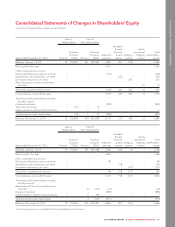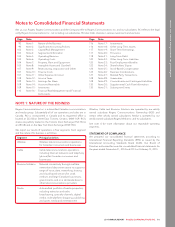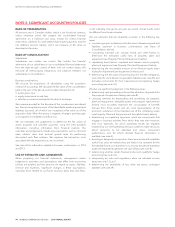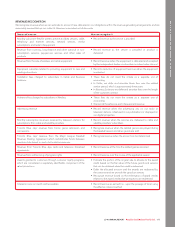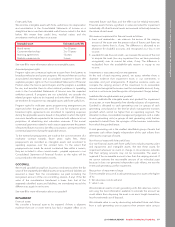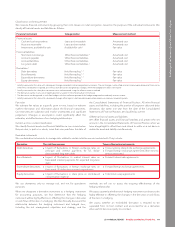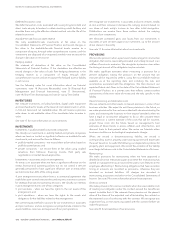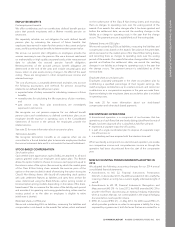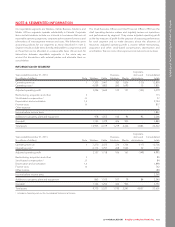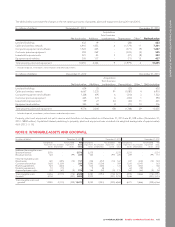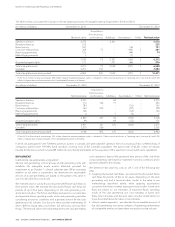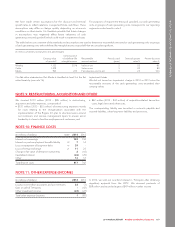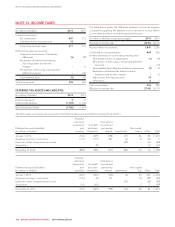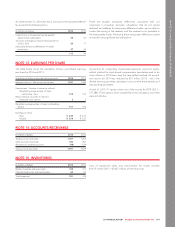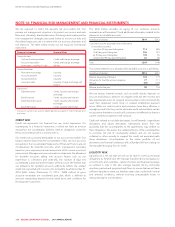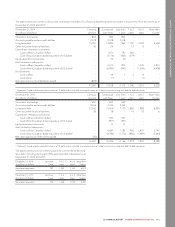Rogers 2014 Annual Report Download - page 105
Download and view the complete annual report
Please find page 105 of the 2014 Rogers annual report below. You can navigate through the pages in the report by either clicking on the pages listed below, or by using the keyword search tool below to find specific information within the annual report.
NOTES TO CONSOLIDATED FINANCIAL STATEMENTS
EMPLOYEE BENEFITS
Post-employment benefits
We offer contributory and non-contributory defined benefit pension
plans that provide employees with a lifetime monthly pension on
retirement.
We separately calculate our net obligation for each defined benefit
pension plan by estimating the amount of future benefits that
employees have earned in return for their service in the current and prior
years, and discounting those benefits to determine their present value.
We accrue our pension plan obligations as employees provide the
services necessary to earn the pension. We use a discount rate based
on market yields on high quality corporate bonds at the measurement
date to calculate the accrued pension benefit obligation.
Remeasurements of the accrued pension benefit obligation are
determined at the end of the year, and include actuarial gains and
losses, return on plan assets and any change in the effect of the asset
ceiling. These are recognized in other comprehensive income and
retained earnings.
The cost of pensions is actuarially determined and takes into account
the following assumptions and methods for pension accounting
related to our defined benefit pension plans:
• expected rates of salary increases for calculating increases in future
benefits;
• mortality rates for calculating thelifeexpectancyofplanmembers;
and
• past service costs from plan amendments are immediately
expensed in net income.
We recognize our net pension expense for our defined benefit
pension plans and contributions to defined contribution plans as an
employee benefit expense in operating costs in the Consolidated
Statements of Income in the periods the employees provide the
related services.
See note 23 for more information about our pension plans.
Termination benefits
We recognize termination benefits as an expense when we are
committedtoaformaldetailedplanto terminate employment before
the normal retirement date and it is not realistic that we will withdraw it.
STOCK-BASED COMPENSATION
Stock option plans
Cash-settled share appreciation rights (SARs) are attached to all stock
options granted under our employee stock option plan. This feature
allows the option holder to choose to receive a cash payment equal to
the intrinsic value of the option (the amount by which the market price
of the Class B Non-Voting share exceeds the exercise price of the
option on the exercise date) instead of exercising the option to acquire
Class B Non-Voting shares. We classify all outstanding stock options
with cash settlement features as liabilities and carry them at their fair
value, determined using the Black-Scholes option pricing model or
trinomial option pricing models, depending on the nature of the share-
based award. We re-measure the fair value of the liability each period
andamortizeittooperatingcostsusing graded vesting, either over the
vesting period or to the date an employee is eligible to retire
(whichever is shorter).
Restricted share unit (RSU) plan
We record outstanding RSUs as liabilities, measuring the liabilities and
compensation costs based on the awards’ fair values, which are based
on the market price of the Class B Non-Voting shares, and recording
them as charges to operating costs over the vesting period of the
awards. If an award’s fair value changes after it has been granted and
before the settlement date, we record the resulting changes in the
liability as a charge to operating costs in the year that the change
occurs. The payment amount is established as of the vesting date.
Deferred share unit (DSU) plan
We record outstanding DSUs as liabilities, measuring the liabilities and
compensation costs based on the awards’ fair values at the grant date,
which are based on the market price of the Class B Non-Voting shares,
and recording them as charges to operating costs over the vesting
period of the awards. If an award’s fair value changes after it has been
granted and before the settlement date, we record the resulting
changes in our liability as a charge to operating costs in the year that
the change occurs. The payment amount is established as of the
exercise date.
Employee share accumulation plan
Employees voluntarily participate in the share accumulation plan by
contributing a specified percentage of their regular earnings. We
match employee contributions up to a certain amount, and record our
contributions as a compensation expense in the year we make them.
Expense relating to the employee share accumulation plan is included
in operating costs.
See note 25 for more information about our stock-based
compensation and other stock-based payments.
DISCONTINUED OPERATIONS
A discontinued operation is a component of our business that has
operations and cash flows that are clearly distinguished from the rest of
Rogers, has been disposed of or is classified as held-for-sale and:
• represents a separate major line of business;
• is part of a single coordinated plan to dispose of a separate major
line of business; or
• is a subsidiary we have acquired with the intention to re-sell.
When we classify a component as a discontinued operation, we restate
our comparative income and comprehensive income as though the
operation had been discontinued from the start of the comparative
year.
NEW ACCOUNTING PRONOUNCEMENTS ADOPTED IN
2014
We adopted the following accounting changes for our 2014 annual
consolidated financial statements.
• Amendments to IAS 32, Financial Instruments: Presentation
(IAS 32) – In December 2011, the IASB amended IAS 32 to clarify the
meaning of when an entity has a current legally enforceable right of
set-off.
• Amendments to IAS 39, Financial Instruments: Recognition and
Measurement (IAS 39) – In June 2013, the IASB amended IAS 39 to
provide relief from discontinuing an existing hedging relationship
when a novation that was not contemplated in the original hedging
documentation meets specific criteria.
• IFRIC 21, Levies (IFRIC 21) – In May 2013, the IASB issued IFRIC 21,
which provides guidance on when to recognize a liability for a levy
imposed by a government, both for levies that are accounted for in
2014 ANNUAL REPORT ROGERS COMMUNICATIONS INC. 101


